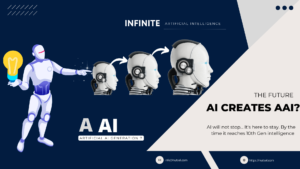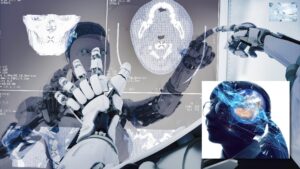3-D printing genuinely looks like the ultimate initiator of the Sci-Fi world full of humanoid robots. As of 2021, 3D printing comprised around 0.1% of the global manufacturing market. 3-D printing technology has been popular for a while now and is getting better with time. How can we forget the “Kengoro” when discussing its application in robotics?
Surprisingly enough, we could use 3-D printing for both the physical body and the brain of a humanoid robot. The current trend in using a humanoid robot is to make it look like a human being. In this context, the physical body of such a robot is usually made up of several rigid parts. However, with 3-D printing technology, the researchers can make its body out of soft materials like rubber and silicon.
The ideal application for such soft bodies is in places that are too dangerous for humans to travel to (comparable to a dystopian future). The Soft Robotics Laboratory at Harvard University has been doing pioneering work in the 3-D printing application in robotics with the design and testing of “Octobot“. The octopus inspired this bot, especially for its ability to swim fast with whatever propulsion it finds available, be it water or air.
Using 3-D printing for the physical body of the humanoid
Earlier in July this year, engineers developed a new design strategy and 3D printing technique to build robots in one single step. The breakthrough resulted in a new 3D printing process for engineered active materials with multiple functions to enable the entire mechanical and electronic systems needed to operate a robot to be produced all at once (also known as metamaterials). A “meta-bot” that has been 3D printed will be able to move, sense, and make decisions.
The human body is certainly a wonder, and the design and manufacturing of human-like body parts, or even the designing of a whole new humanoid robot, is something only humans can imagine doing. Here are a few of the most major developments in this field:
- Check Out This Walking Robot—3D Printed and Fully Functional in Just 22 Hours.
- Manufacturers have developed a one-step, all-in-one 3D printing process to produce materials for robotics.
- HydraX, a robotic arm for hybrid manufacturing that was 3D printed. Part I: Specialized Design, Manufacturing, and Assembly.
- Goo soon transforms into a hand via 3D printing.
Using 3-D printing for cognitive abilities
We can’t 3-D-print brains, can we? Well, in 2021, a team of researchers from the University of Montréal, Concordia University, and the Federal University of Santa Catarina successfully 3D printed living mouse brain cells using a newly developed bioprinting technology.
The scientists used their Laser-Induced Side Transfer (LIST) technology to produce sensory neurons, a vital component of the peripheral nervous system, most of which remained alive two days after printing. The team ran several tests to measure the capacity of the printed cells, which they believe could help significantly advance the field of bioprinting.
The human cerebral cortex is nearly 1,000 times larger in both area and number of neurons than that of the mouse cerebral cortex. And regardless of that, it’s really complex to simulate or recreate a human brain. There are some unanswered questions related to this technological development, such as “does it take much time to produce a simple brain structure by 3-D printing, or is there a requirement for a high level of accuracy in accuracy?”
However, can we say that a 3-D printed humanoid robot can feel? Can it love? Can it learn on its own? And, can it feel pain the way humans do? The answer is difficult to find because all humans have different brains, and brains with different connections respond in their ways to stimuli. We don’t exactly know which human we’re actually referring to.
How would a 3-D printed humanoid work?
As mentioned a few times in the previous articles, imitation is not necessary. A humanoid robot could be different in several ways but still better than a human adult, if not a child. For example, a robot wouldn’t require food and drink or sleep. It would be completely independent. It would not suffer from diseases or any other physical issues. More importantly, it could survive on Venus, for instance.
3-D printing is one of the few technologies with futuristic potential, along with artificial intelligence and virtual/augmented reality.
Not to mention the recent “3-D-Printed ear transplant” of a 20-year-old girl. This experimental process involved taking a biopsy from the patient’s existing ear and pulling out cartilage cells. The scientists then construct the patient’s ear using 3D printing after they have created the cells.
As of now, 82% of 3D printing is done using plastic as the printing material. However, if we give ourselves a little longer to develop, the 3D printer could synthesize the printing material. For instance, imagine a normal printer that uses sand instead of ink.
And, with more time to develop, 3-D printers may be able to print their own building materials as they work! It’s not difficult to imagine an AI-powered 3-D printer deciding by itself what new material it needs next on the scaffold. As weird as it may sound, we may need an advanced AI-powered 3D printer to build an AI-powered humanoid robot.
Can an AI-Powered 3D printer create an AI-Powered Humanoid?
When it comes to 3D printing, AI has a wide range of benefits, including the capability to evaluate an object before the process starts and to predict the quality of the part. The fixation process is enhanced and production waste is reduced through the use of machine learning algorithms. Some efforts even aim to achieve additive manufacturing with zero waste. We can also use AI to protect important data about the printing process, such as reducing the number of errors.
Imagination and innovation come closer than ever with 3-D printing. We’ve seen how they can work together to create a prosthetic hand, some of the most realistic prosthetic hands we’ve seen to date. There are a number of other ways AI and 3D printing can work together, including the design and creation of new materials that could turn out to be the key element for building humanoid robots.
3-D printing can help in a number of ways. 3D printing improves fabrication, prototyping, and tooling, and reduces cost and time to market. It is quite useful for robotic engineers to accomplish their objectives. It expedites product design while reducing costs and waste. Doing this gives designers more creative freedom to make complex designs. And the flexibility of 3-D printing is unmatched. This can happen without 3-D printing, but it’s going to go much faster with it.
And for creating artificial brains, 3-D printing could play a key, exclusive role. Deploying an artificial brain structure into reality would be more effective, not just easier, with 3-D printing. It can help create a more standardized process, ensuring that we are creating devices in an appropriate way. As we described earlier, we can also use 3D printing to create custom-designed components.
3-D printing, therefore, is one of the main pillars that will lead us towards such a thing; artificial intelligence and its ability to create AI-Powered Humanoid Robots.
- AI-Powered PCs: Overhyped Trend or Emerging Reality? - August 21, 2024
- Princeton’s AI revolutionizes fusion reactor performance - August 7, 2024
- Large language models could revolutionize finance sector within two years - March 27, 2024



